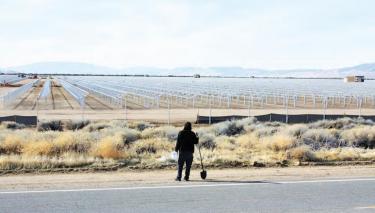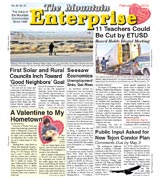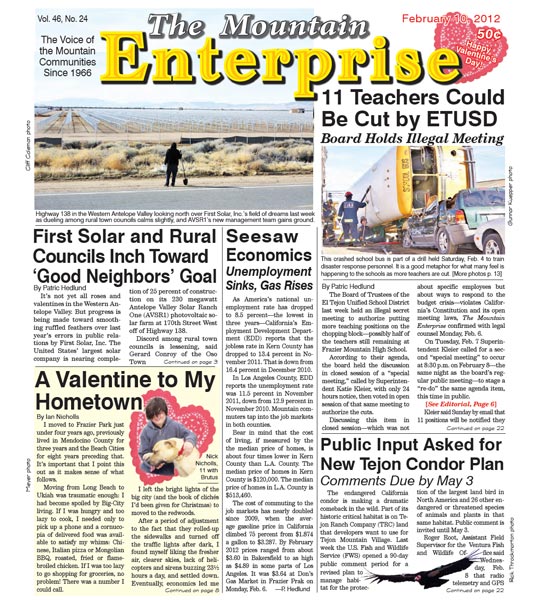
Highway 138 in the Western Antelope Valley looking north over the First Solar, Inc. field of dreams last week as dueling among rural town councils calms slightly and the new management team for AVSR1 gains ground.
By Patric Hedlund
UPDATE: See Breaking News report above about new challenges to the First Solar project in the Antelope Valley.
It’s not yet all roses and valentines in the Western Antelope Valley. But progress is being made toward smoothing ruffled feathers over last year’s errors in public relations by First Solar, Inc. The United States’ largest solar company is nearing completion of 25 percent of construction on its 230 megawatt Antelope Valley Solar Ranch One (AVSR1) photovoltaic solar farm at 170th Street West off of Highway 138.
Discord among rural town councils is lessening, said Gerard Conroy of the Oso Town Council, after a second meeting at the Fox Field Airport. There are still rough patches yet ahead, town council members report. At one time it was estimated that 33 renewable energy developers were seeking to place solar or wind farms in the Western Antelope Valley. That leaves room for a great deal more disharmony between neighbors.
On January 15 a police report was filed about alleged aggressive behavior and threatening comments by a Western Antelope Valley resident against the president of the Fairmont Town council.
David Kerr, a Los Angeles County Sheriff’s deputy, said he felt it was wise to put on the record that Jeff Olesh had made what he considered to be threatening remarks in September, October and December 2011.
Kerr attributes the threats to the passionate opposition that Olesh and others have to wind turbines proposed along Portal Ridge by NextEra NRG’s Blue Sky project and Element Power, Inc.’s plans for land adjacent to the California Poppy Preserve.
On January 25 a reporter for Antelope Valley Press quoted Jeff Olesh as saying ““There’s so much corruption and so much money…At this point, Fairmont is being offered—not on paper but verbally—$2 million. It was common knowledge that (Element) had offered the Fairmont Town Council $2 million if they don’t oppose the wind turbines. So their vote in non-opposition of the [meteorological] towers is a result of this $2 million hanging out there.”
The reporter did not make an attempt to substantiate the charge of corruption. Kerr said the defamatory charge is absurd and that the council was offered $5,000 to cover legal fees when the company asked them to review legal documents, but that they turned the offer down. Attempts at press time to reach Olesh were not successful.
On February 7 at Fox Field, members of the Three Points, Antelope Acres, Oso and Fairmont Town Councils met with executives from First Solar, Inc. and Norm Hickling, deputy for Supervisor Michael Antonovich.
First Solar was roundly applauded for crisp, factual answers to issues of concern, from how many local people had been hired to how much water is being pumped from the aquifer to what kind of dust abatement chemicals are being applied to the soil.
Although 37 local workers were laid off at the end of December, 31 local workers have been rehired, according to Senior Vice President Jim Lamon, and 12 more will be hired in the coming week. Meanwhile, the NRG Alpine project is beginning to be built. Open house receptions are being held by both sites.
Earlier in this series:
2011-06-24 Fairmont Town Council’s Solar Merry-Go-Round Ride
2011-06-24 Update: Fairmont Town Council Asks for Emergency Planning Meeting on First Solar Intentions
2011-05-06 Where the Trees Grow Sideways and the Sun Burns Bright
2011-04-29 ‘Where the Trees Grow Sideways and the Sun Burns Bright’
2011-04-08 150 Hear about NextEra Wind Farm at The Lakes Town Council
2011-04-01 Fairmont Council Votes To Settle with NRG Solar
2011-03-25 Fairmont Town Council Makes Progress on NRG Appeal
l2011-03-11 Oso Town Council Is Revived as Wind and Solar Farms Arrive
2011-02-11 Neenach-Fairmont Area Meet Energy Developers–Part Three
2011-02-04 Neenach-Fairmont Meet With Energy Developers-Part Two
2011-01-28 Neenach-Fairmont Meet With Energy Developers
2011-01-21 Energy Groups Rushing into Neenach Area
2011-01-14 Breaking News: Solar Companies Seek Thursday Meeting in Neenach
2011-01-07 Neenach Area Files Two Appeals to L.A. County Solar Farm Permit :
2010-12-31 Breaking News: Neenach Area Residents Appeal Permit for 800-Acre Solar Farm
By Patric Hedlund
It’s hard to say what a bad week might feel like for an $11 billion corporation named by Forbes Magazine as the fastest growing technology company in America two years in a row, but First Solar Inc.’s unpleasant encounter with the Fairmont Town Council in Western Antelope Valley this week caught the eye of some Wall Street investors. The company, known as FSLR on the NASDAQ, is seeking to place a 2,100 acre, 230 megawatt system, the largest in California, in the Fairmont area.
With loan guarantees and grants, there is about $215 million in federal incentive benefit to FSLR if it can commence construction before September 30, one Wall Street analyst who contacted The Mountain Enterprise estimates. FSLR received a certification of its Environmental Impact Report (EIR) for the Antelope Valley Ranch One project in November 2010, shortly after the Fairmont Town Council was formed.
FSLR hopes to break ground by July 5, development manager Jack Pigott told about 45 Fairmont residents June 27. The group gathered at the WeeVill Market, one of the few public structures along a flat stretch of Highway 138, about 15 miles west of Lancaster.
After hearing a presentation by Pigott and Roy Skinner, First Solar permits specialist, Fairmont Town Council members and residents asked pointed questions about the transformations that will take place in their valley from the cumulative impact of 33 utility-scale renewable energy installations slated to be built in their area.
Their primary grievance, according to council president David Kerr, is the lack of consultation with the neighbors who will be most immediately affected by the facility.
Council President David Kerr said that First Solar had not notified its immediate neighbors to give them an opportunity to be part of the EIR hearing process. First Solar representatives said that L.A. County had notified neighbors in mailings. Residents ridiculed the reply, saying that rural mail addressed to street boxes is often not delivered nor received, and that none of them had received notification. Only one resident, Pat Chiodo, said he had been to an EIR hearing at Antelope Acres Town Council, about 15 miles from the Fairmont area.
Residents said it appears that L.A. County employees in Supervisor Antonovich’s office or in downtown L.A. had misinformed the solar company regarding who represents the 2,000 residents who live where the company hopes to build AV Solar Ranch One.
“We are the ones who will be paying for this project and the other ones that want to build here, with the change to our way of life,” Kerr said.
The council voted to send a letter seeking an urgent emergency meeting with the Los Angeles County Department of Regional Planning.
The letter, signed by residents as well as the council, speaks of "glaring insufficiencies" in the design and construction plans for AV Solar Ranch One.
Specific complaint was made about what was characterized as the failure of the company to make "meaningful" contact with residents. It also said the proposed project is inconsistent with the "principles and values stated in the [L.A. County] Antelope Valley Area Plan."
In strong words, the letter said that architects of the project are obliged to make a "collaborative effort" with community members, but that they had not. The council’s letter calls AV Solar Ranch One "a bullying, unwanted neighbor whose pursuit of profits apparently has blinded it to any concepts of area cooperation," then asks for an immediate review of the project "prior to commencement of construction."
Pigott said many of the concerns mentioned by residents had already been addressed in the EIR, and reminded the group that the project had already been approved by downtown L.A. He said that the Fairmont Town Council should become familiar with the EIR mitigation components before submitting the letter.
Cumulative impact issues were raised throughout the meeting. Many spoke of the 7-foot chain link fences topped with barbed wire throughout the valley around 33 projects that will turn the valley’s open landscape into a penitentiary environment.
One father said “I want to see a landscape plan to hide that fence all around the whole project. It is like living next to a correctional institution. I am for solar, but you need to come in and handle the concerns of the community. We’re no different from Napa, Sonoma and communities up north, [that have] nice pine trees [to screen solar farms]. The idea of using Joshua trees won’t work. We don’t want to look at that—and most of them die. My kids will get stuck looking at a chainlink fence desert.”
Pigott dismissed their anxiety, saying the setbacks and landscaping along paved roads for his project would be adequate. He repeated that the company adhered to the requests of L.A. County Planning Department personnel. Rural residents scoffed at the "ignorance" of urban planners regarding the needs of the rural community.
The town council voted to table “for the moment” a motion to file a restraining order that could delay the beginning of AV Solar Ranch One construction.
The next day, on Tuesday, June 28, Riverside County Supervisor John Benoit introduced a motion regarding a two percent franchise fee on another large First Solar installation planned to be built in Riverside County. According to Benoit’s press coordinator, the motion has been sent for further study by county staff. The two percent fee could total $3.5 million a year in revenues to the county, it was estimated it could mean nearly $100 million over the life of the project.
When Benoit’s proposal was mentioned at the Fairmont meeting, Pigott laughed. "We will never pay that," he said.
First Solar’s stock closed on Wednesday, June 29 at $129.42. Recent news of popular desire in Germany to close down its nuclear power plants due to safety concerns make First Solar’s thin film photovoltaic offerings hotter than ever. The company already has large solar energy installations in Germany. The day after Fairmont Town Council submitteed its letter, FSLR stock rose $4.81 per share.
This is part of the February 10, 2012 online edition of The Mountain Enterprise.
Have an opinion on this matter? We'd like to hear from you.


